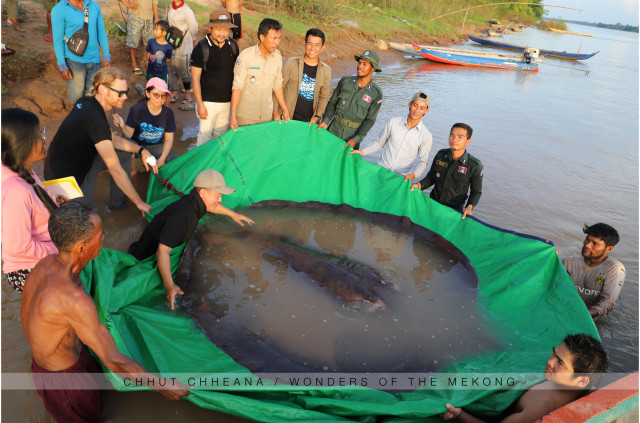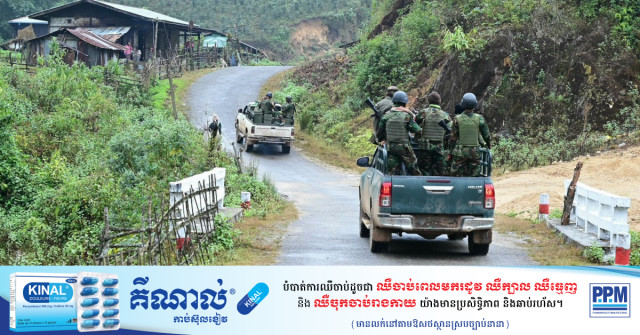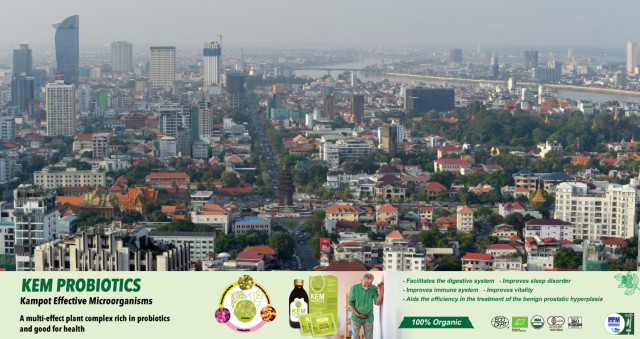World’s Largest Freshwater Fish Found in Mekong River

- By Teng Yalirozy
- June 21, 2022 3:00 PM
The record-breaking discovery follows another imposing stingray catch in May 2022, weighing 181 kilograms
PHNOM PENH – A 300 kilograms giant freshwater stingray has been discovered near a remote island in the Mekong River, making it the world’s largest freshwater fish ever discovered. It is even heavier than Mekong’s giant catfish record, caught in Thailand in 2005 and weighing 292 kilograms.
A fisherman on June 13 caught the record-breaking stingray, which measured almost four meters (over 13 feet) from snout to tail. The catch was made south of Stung Treng city, in the middle sections of the Mekong River as it meanders through northern Cambodia. The endangered ray has been released back to the river with the assistance of the USAID-funded Wonders of the Mekong Project.
“Cambodia is blessed with incredible biodiversity and we are proud of the team’s efforts to promote sustainable management and raise public awareness on the important role of the Mekong River,” said Hanh Nguyen, USAID Acting Mission Director in Cambodia.
The stingray discovery is proof that the biosphere can still yield extraordinary discoveries, and that many of the world's biggest aquatic creatures remain sorely understudied, said Zeb Hogan, a fish biologist at the University of Nevada, Reno.
“In 20 years of researching giant fish in rivers and lakes on six continents, this is the largest freshwater fish that we’ve encountered or that’s been documented anywhere worldwide,” said Hogan.
International scientists, Cambodian fishery officials, and community members gathered to witness the release of the enormous female stingray, who was named “Boramy”, which means “full moon” in Khmer, as it was released at dusk with the moon gleaming on the horizon.
New opportunities for rare species discovery
In May 2022, also in Stung Treng province, a large endangered big freshwater stingray weighing 181 kilograms was also caught.
“The discovery of this world record stingray indicates the special opportunity we have in Cambodia to protect this species and its core habitat,” said Poum Sotha, director general of the Fisheries Administration.
Heng Kong, director of the National Aquaculture Research and Development Institute, Fisheries Administration, said that Cambodia still has many understudied rare species. Fisheries administration have partnered with various organizations, such as WWF, working to preserve the endangered species in Cambodia.
He said that parts of the Mekong River located in Stung Treng province have been found as the last habitat of rare species by researchers from Washington D.C. “There are many rare species in the river though we can’t find out the exact numbers,” he said.
More efforts are needed to protect and preserve the rare biodiversity
Wonders of the Mekong Project has developed a network of fishermen who are committed to record captures of enormous and endangered species, including stingrays, in partnership with the Cambodian Fisheries Administration, according to the press release issued on June 20.
Chea Seila, program manager for Wonders of the Mekong said that “fishers now cooperate with our project when they find giant stingrays so that we can tag and release them. These successful releases illustrate the importance of partnerships with local communities. Together, we all have an important role to play in fisheries monitoring and conservation.”
“In partnership with the Wonders of the Mekong Project, and together with other countries in the Lower Mekong Basin, the Inland Fisheries Research and Development Institute of the Cambodian Fisheries Administration will host a meeting to map out a regional species conservation action plan and solidify safeguards for the river, wildlife, fisheries, and local communities,” said Poum Sotha, director general of the Fisheries Administration.
Heng Kong, from the National Aquaculture Research and Development Institute, added that the fishery administration, local authorities and local communities play vital roles to protect the biodiversity in Cambodia.
Illegal fishing has been banned in some areas, while some communities are allowed to fish on a family scale, he said. Therefore, communities have to be cooperative with the authorities as well as the fisheries administration.
He went on to say that the threats posed to biodiversity include the construction of hydropower dams, climate change, and the conversion of wetlands to agricultural land. “Those types of land don’t have any forest cover, so when it rains, it brings the sediments from the soil into the river,” he said.
“There must be cooperation between the administration, the authorities, and the commune or district council. Conservation work demands cooperation between every stakeholder”, Kong said.
The Mekong River is one of Asia's most powerful rivers and is the world’s 12th longest river. It flows through China, Burma, Laos, Thailand, Cambodia, and Vietnam.
The Mekong River enters Cambodia in the northeast, near the border with Laos, in the province of Steung Treng. It then flows southwest through the provinces of Kratie, Kompong Cham, and Kandal. It then joins the Tonle Sap River in Phnom Penh, before flowing south to Vietnam in two main streams, Mekong and Tonle Bassac Rivers.















